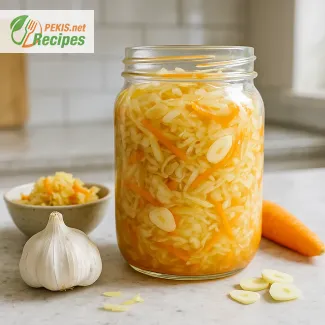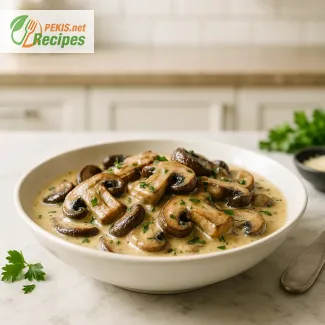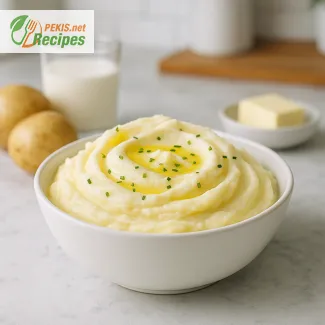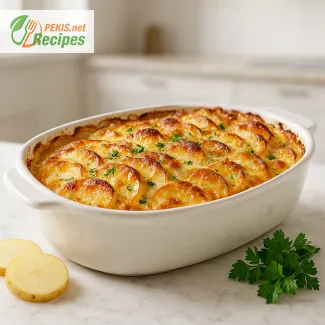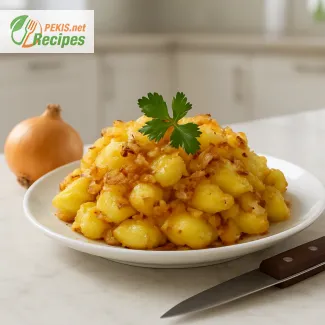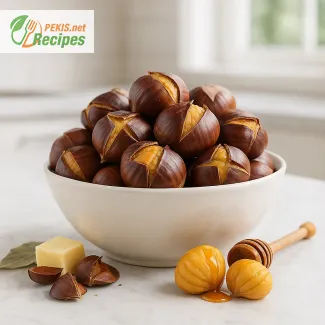Crispy smashed potatoes turn humble baby potatoes, olive oil, butter, garlic and herbs into golden, craggy bites with shattering edges and a soft, fluffy centre. Born from simple boiled potatoes, this viral comfort side dish now steals the spotlight from the main course and brings pure crunchy, garlicky comfort to the table.
Years of testing potato sides proved that the real magic in crispy smashed potatoes happens before the tray hits the oven – letting the potatoes steam-dry gives those wild, craggy edges that turn ultra-crunchy. PEKIS – professional chef and recipe developer with more than 25 years of experience in cooking and baking, specialized in European and international cuisine.
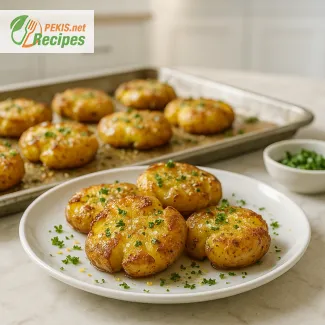
Viral crispy smashed potatoes for golden, crunchy comfort
Rustic smashed potatoes with crispy edges and fluffy centres
Cracks of golden, crispy potato echo on the baking tray as the fork presses down, turning small boiled potatoes into rustic, craggy rounds. Steam escapes, the inside stays soft and fluffy, and every broken edge becomes a perfect surface for olive oil, garlic, herbs and salt to cling to. One tray on the table and suddenly the main dish loses attention – crispy smashed potatoes sit in the spotlight as the ultimate comfort side dish that feels simple, homely and a little bit indulgent at the same time.
The idea began as a clever way to use boiled potatoes that felt too boring on their own. Instead of serving them whole, they are lightly smashed, drizzled with fat and seasoning, then roasted at high heat until the edges turn deeply caramelised and the bottoms pick up a satisfying crunch. The result lands somewhere between roasted potatoes, fries and hash browns, with all the best qualities of each. That is why these viral smashed potatoes keep appearing in feeds, on weeknight dinner tables and even alongside roasts for guests.
Historically, versions of “smashed” potatoes appeared wherever cooks wanted maximum texture from basic ingredients. In many European kitchens, potatoes were parboiled, flattened and finished in fat on a pan or in the oven to stretch leftovers and add flavour. The modern, social-media-driven version simply turns up the volume: more high heat, more crisp edges, generous garlic butter or herb oil, sometimes a sprinkle of Parmesan or smoked paprika for extra depth. Rustic presentation and irregular shapes make each piece look handcrafted, not factory-perfect.
Because the method is so forgiving, smashed potatoes fit easily around other potato classics. On days when a layered bake feels more appropriate, many cooks reach for a creamy dish like The best potato gratin, which offers a smoother, more creamy comfort next to the crunchy drama of smashed potatoes. For something cooked in a pan instead of the oven, there is also the option of Perfect Pan-Fried Potatoes with Onion – Boiled First for Extra Flavor, where onion sweetness and golden potato slices bring a different style of comfort to the plate. Together, these dishes create a small universe of potato sides that match different moods and menus without competing directly.
Why crispy smashed potatoes feel so satisfying
- Crispy edges, fluffy centres: the contrast between crunchy exterior and soft inside hits the same pleasure zone as good fries or roast potatoes.
- Simple ingredients, big payoff: basic potatoes, oil, salt, garlic and herbs turn into a side that looks restaurant-worthy.
- Highly adaptable flavour: toppings can lean garlicky and buttery, herb-forward, spicy or even cheesy, depending on the meal.
- Works with many mains: pairs well with roast chicken, grilled steak, baked fish, veggie patties or simple fried eggs.
- Visually impressive: irregular shapes, browned ridges and golden colour look striking in photos and on the table.
Smashed potato essentials: texture, fat and high heat
The character of crispy smashed potatoes rests on three pillars: properly cooked potatoes, the right fat and sustained high heat. Potatoes need to be boiled until just tender so they smash easily without falling apart completely. Fat – whether olive oil, melted butter, duck fat or a mix – must be enough to coat every surface so that the oven can create that intense crisp crust. High heat finishes the job, turning pale potatoes into deeply browned pieces with tiny blistered spots and a roasted aroma.
Seasonings layer on top of this foundation. Garlic, fresh herbs like rosemary, thyme or parsley, sea salt, black pepper, chili flakes, lemon zest or grated hard cheese all interact differently with the crisped surfaces. Some cooks prefer to add delicate ingredients after baking to keep them fresh and bright, while sturdier flavours such as smoked spices or dried herbs can go on earlier so they toast slightly in the oven.
Creative variations with familiar pantry ingredients
- Garlic and herb smashed potatoes: finished with garlic butter, chopped parsley, chives or rosemary for classic roast-dinner flavour.
- Cheesy smashed potatoes: topped with Parmesan, Cheddar or another hard cheese near the end of baking for a crispy, savoury crust.
- Spicy smashed potatoes: seasoned with chili flakes, smoked paprika or a drizzle of chili oil for a gentle or bold kick.
- Lemon and herb smashed potatoes: combined with lemon zest and fresh herbs for a lighter, more Mediterranean profile.
- Yogurt or sour cream drizzle: served with cool, tangy sauces that contrast the warmth and crispness of the potatoes.
Storage and make-ahead tips for crispy smashed potatoes
Smashed potatoes adapt well to a busy schedule. Potatoes can be boiled and cooled in advance, then stored in the refrigerator before smashing and roasting. This makes it easy to prepare part of the work earlier in the day or even the day before a gathering. Leftover baked potatoes can also be turned into smashed potatoes the next day, extending their life in a more exciting form.
Once fully baked, any leftovers keep in an airtight container in the fridge. Reheating in a hot oven or air fryer revives much of the crisp texture, especially if the potatoes are spread out in a single layer. Microwaving will warm them but softens the crust, so dry heat remains the preferred method when possible.
Crispy smashed potatoes in the world of potato side dishes
Crispy smashed potatoes sit neatly beside other potato favourites such as potato gratin, pan-fried potatoes with onion, roasted baby potatoes and herbed mash. Each option highlights a different combination of texture, fat, seasoning and cooking method, so they complement rather than compete with one another. This particular dish focuses on high surface area and intense browning, delivering maximum crunch without losing the gentle, familiar flavour that makes potatoes such a trusted choice for both everyday meals and special occasions.
- Prepare and boil the potatoes
Place the baby potatoes in a large pot, cover with cold water and add a small pinch of salt. Bring to a boil, then reduce to a gentle simmer. Cook until the potatoes are just tender when pierced with the tip of a knife but not falling apart, usually 12–15 minutes depending on size. Drain carefully and let the potatoes steam-dry in the colander for a few minutes so excess moisture can escape. This step helps them become extra crispy in the oven. - Preheat the oven and prepare the baking tray
While the potatoes are drying, preheat the oven to 220°C (428°F). Line a large baking sheet with baking paper or lightly brush it with olive oil to prevent sticking. A wide tray with enough space between the potatoes is important so they can roast, not steam. - Smash the potatoes for maximum crispiness
Arrange the boiled potatoes on the prepared baking tray, leaving a little space between each one. Using the bottom of a sturdy glass, a potato masher or a fork, gently press down on each potato until it flattens into a rustic round. Aim for an even thickness so the edges become crispy while the centres stay soft and fluffy. Try not to press so hard that the potatoes completely fall apart; a few cracks and rough edges are ideal. - Season with fat, garlic and herbs
In a small bowl, whisk together the olive oil and melted unsalted butter until combined. Add the minced garlic, finely chopped rosemary and thyme leaves. Season this mixture with the fine sea salt and freshly ground black pepper. Drizzle or brush this aromatic fat mixture generously over each smashed potato, making sure it seeps into the cracks and coats the surface. The more contact the fat has with the potato, the better the golden, crispy crust will be. - Roast until deeply golden and crisp
Place the tray in the preheated oven and bake for 25–30 minutes, or until the potatoes are rich golden brown around the edges and the bottoms are crisp. If needed, rotate the tray once during baking to ensure even colour. In the last 5 minutes of roasting, sprinkle the grated Parmesan cheese evenly over the potatoes so it melts and forms a savoury, slightly crunchy topping without burning. - Finish with fresh garnish and lemon zest
Once the potatoes are deeply browned and crisp, remove the tray from the oven. While still hot, sprinkle the smashed potatoes with the finely chopped fresh parsley and a little extra black pepper if desired. Add a light dusting of lemon zest over the top for brightness; it cuts through the richness of the butter and cheese and lifts the flavour of the roasted potatoes. Taste and adjust with a pinch of extra fine sea salt if needed. - Serve immediately
Transfer the crispy smashed potatoes to a warm serving dish, keeping as many of the crunchy, caramelised edges intact as possible. Serve as a comfort side dish alongside roast chicken, grilled steak, baked fish or vegetarian mains. The potatoes are best enjoyed hot from the oven, when the edges are at their crispiest and the centres are still tender and fluffy.
Storage and reheating
- Allow any leftover smashed potatoes to cool completely, then place them in an airtight container and refrigerate for up to 3 days.
- Reheat on a baking tray in a hot oven at 200°C (392°F) for 10–12 minutes, or in an air fryer, until the edges are once again crispy and the centres are heated through.
- Avoid reheating in the microwave if possible, as this tends to soften the crust and reduce the desired crunchy texture.
FAQ questionHow do you get smashed potatoes really crispy without drying them out?
The key is to maximise surface area and dry heat without overcooking the inside. Boil the potatoes only until just fork-tender, then let them steam-dry in the colander so excess moisture evaporates. When smashing, create plenty of craggy edges but keep the centres intact. Coat every surface with olive oil and melted butter, then roast on a large tray at high heat with enough space between potatoes so they roast, not steam. This combination gives shattering edges and a soft, fluffy centre.
FAQ questionWhich potatoes are best for crispy smashed potatoes?
Small waxy or all-purpose potatoes work best because they hold their shape while still becoming tender inside. Look for baby potatoes or small new potatoes with thin skin; the skin adds extra texture and flavour. Very starchy potatoes can crumble too easily when smashed, while very large potatoes take longer to cook and may not crisp evenly. Choosing similar-sized potatoes helps them cook at the same rate so the whole tray turns golden at once.
FAQ questionCan crispy smashed potatoes be prepared in advance?
Yes, the recipe is very make-ahead friendly. Boil the potatoes earlier in the day (or even the day before), drain them and let them cool completely. Store them covered in the fridge. When ready to serve, arrange on the tray, smash, season with garlic, herbs and fat, then roast until crisp. This two-step approach makes entertaining easier and still gives fresh-from-the-oven crunch. Leftovers can also be reheated in a hot oven or air fryer to revive much of their original crispiness.
FAQ questionWhat oven temperature is best for crispy smashed potatoes?
A high oven temperature around 220°C (428°F) is ideal. At this heat, the potatoes develop a deep golden colour and crisp exterior before the inside dries out. Lower temperatures tend to soften and dehydrate the potatoes rather than crisp them, while very high heat can burn garlic and cheese. If the potatoes are browning unevenly, rotating the tray and giving them a few extra minutes usually balances colour and texture.
FAQ questionHow can the flavour of crispy smashed potatoes be changed without losing the crunch?
The base stays the same – boiled, smashed potatoes with oil or butter at high heat – but the flavour profile can shift with different toppings. For a classic version, use garlic, rosemary, thyme and Parmesan. For a bolder side, add smoked paprika, chili flakes or chili oil. A fresher, lighter take uses lemon zest and soft herbs like parsley and chives added after baking. Sauces such as garlic yogurt, sour cream or aioli can be served on the side so the potatoes stay crisp while diners add creaminess on the plate.
FAQ questionWhy do my smashed potatoes stick to the tray, and how can I prevent it?
Sticking usually happens when there is too little fat or the tray surface is not prepared. Line the tray with baking paper or lightly oil the metal surface before adding potatoes. After smashing, make sure every potato is generously coated with olive oil and melted butter, especially underneath and around the edges. Avoid moving the potatoes too early; they release more easily once a golden crust has formed. This not only prevents sticking but enhances the crunchy bottom layer that makes crispy smashed potatoes so addictive.
Golden trays of crispy smashed potatoes have a way of turning even an ordinary dinner into something that feels special. The mix of golden edges, fluffy centres and the aroma of garlic, butter and herbs makes the whole kitchen smell inviting before the first plate is served. Each craggy, roasted potato carries just enough richness to feel indulgent, yet still pairs effortlessly with simple weeknight mains or more elaborate festive dishes.
On busy days, the ease of boiling potatoes in advance and finishing them in the oven later means there is always room for a comfort side dish that does not demand constant attention. The method remains wonderfully forgiving: as long as the potatoes are tender, well-smashed and generously coated in fat, the oven takes care of the rest. That reliability makes crispy smashed potatoes a trusted choice when cooking for family, friends or larger gatherings.
The flexibility of the flavour profile also keeps the dish exciting. A classic version with garlic, rosemary, thyme and Parmesan suits roasts and grilled meats, while a brighter version with lemon zest and fresh herbs works well with fish or lighter mains. Turning up the heat with chili flakes or smoked paprika creates a bolder side that fits casual barbecues and sharing platters. Within the same basic technique, it is easy to adapt to seasons, occasions and personal tastes.
Over time, this simple idea of boiling, smashing and roasting has grown into a modern staple alongside other beloved potato dishes. With the right balance of texture, heat and seasoning, crispy smashed potatoes consistently earn a spot at the centre of the table, not just as an extra, but as one of the main reasons everyone looks forward to the meal.
Allergens present in the recipe
- Milk / dairy: present – from the unsalted butter and Parmesan cheese used in the fat mixture and topping.
- Lactose: present – naturally occurring in the butter and Parmesan cheese.
- Gluten: not present in the core ingredients; the recipe is naturally gluten-free when using pure potatoes, butter, oil, herbs and cheese. Check labels for any “may contain” traces if strict gluten avoidance is required.
Tips to remove allergens and gluten
- Milk / dairy / lactose-free version: replace the butter with additional olive oil in equal quantity and omit the Parmesan cheese, or use a lactose-free hard cheese alternative. This keeps the potatoes crispy and flavourful while removing dairy.
- Gluten-sensitive or coeliac-friendly version: choose certified gluten-free Parmesan or a suitable hard cheese and ensure seasonings such as spice mixes and stock powders (if used) are labelled gluten-free. Avoid cross-contamination by using clean utensils and baking paper.
- Vegan version: use only olive oil or another plant-based oil instead of butter and skip the Parmesan cheese or substitute with a plant-based hard cheese alternative.
- Vitamin C (mg): 20 – supports normal immune function and helps protect cells from oxidative stress.
- Vitamin B6 (mg): 0.5 – contributes to normal energy metabolism and nervous system function.
- Potassium (mg): 900 – helps maintain normal blood pressure and supports proper muscle function.
- Iron (mg): 1.5 – contributes to normal oxygen transport in the body and reduces tiredness and fatigue.
- Calcium (mg): 80 – supports normal bones and teeth, partly supplied by the Parmesan cheese.
- Phenolic compounds (mg): 40 – naturally present in potato skins and may help protect cells from oxidative damage.
- Carotenoids (mg): 0.3 – found in potatoes and butter, support normal vision and act as antioxidants.
- Vitamin E (mg): 1.5 – provided mainly by olive oil, contributes to the protection of cells from oxidative stress.
